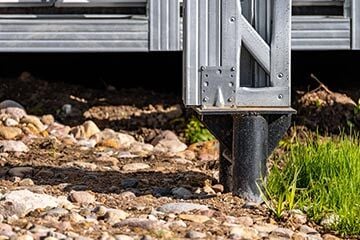Not every crack in your wall is a reason to panic. Some are harmless and easy to fix, while others can point to bigger problems.
In this guide, we'll walk you through the most common causes, the different types of cracks to look out for, and when it might be time to take action.
And if you're worried about cover, we'll also explain how home insurance fits into the picture.

What are the main causes of cracks in walls?
Cracks in your walls can look alarming, but they're not always a sign of major trouble. Some are just part of a home's natural ageing process, while others need a closer look.
Here are some of the most common causes:
-
Drying plaster - hairline cracks often appear as plaster dries out.
-
House settling - new builds in particular can shift slightly as they bed in, leaving small cracks.
-
Temperature changes - hot and cold weather can cause walls to expand and contract.
-
Water leaks - moisture can weaken walls, leading to more noticeable cracks.
-
Subsidence - when the ground beneath your home shifts, it can put strain on the structure.
-
Structural issues - in some cases, cracks point to deeper problems with your home's foundations.
Most cracks are harmless, but if they're wide, spreading or suddenly appear, it's best to get them checked out.
What are the different types of cracks in walls and ceilings?
Spotting a crack in your wall can set off alarm bells. But before you worry, it helps to know the different types and what they could mean:
Vertical cracks in walls
Vertical cracks often look scarier than they are. They're usually a sign of your house settling or plaster drying out - both very common. Small, thin cracks like these are rarely a big deal. But if you notice them getting wider, it could point to something more serious, so it's worth keeping an eye on.
Horizontal cracks in walls
These ones need attention. Horizontal cracks can be linked to structural issues, like weakened foundations or failing wall ties. They don't always mean disaster, but they're a stronger warning sign than vertical cracks. If you spot one, it's best to get a professional to take a look.
Diagonal or stair-step cracks
Cracks that travel at an angle, often near windows and doors, are worth investigating. They can indicate subsidence - when the ground beneath your home shifts or sinks. Left unchecked, they may spread and cause bigger problems. If you see a zig-zag pattern forming, it's time to call in the experts.
Hairline cracks
These are the little ones - thin, shallow lines that often appear as plaster dries or your home expands and contracts with temperature changes. They're usually harmless and easy to fix with filler and paint. If they start spreading or growing wider, though, it could be a sign of something more serious.
When should I worry about cracks in walls and ceilings?
The key is knowing which ones to keep an eye on.
Look out for these red flags:
-
Cracks wider than a pound coin
-
Diagonal cracks, especially above doors and windows
-
New cracks that appear suddenly
-
Light visible through the crack
If you spot any of these, it's a good idea to call a structural engineer. Hairline cracks are usually harmless, but bigger ones could point to subsidence or another structural issue.
What is subsidence and will my home insurance cover it?
Subsidence is when the ground under your home shifts or sinks, pulling at the foundations and often leaving cracks in your walls. It can look scary, but not all cracks mean subsidence - plenty are caused by less serious issues.
The good news is that most buildings insurance policies do cover subsidence, so you won't be left to foot the bill if it happens. Just be sure to check the small print of your home insurance, as settlement cracks (the harmless ones that often appear in new builds as they 'bed in') are usually excluded.
If you ever need to claim, be prepared that your insurer may ask for reports, surveys and photos. The process can take a while, but that's because subsidence claims are complex and insurers want to be certain the right repairs are carried out properly.
How do I fix cracks in my walls?
Hairline cracks are usually quick DIY jobs - a bit of filler, a sand down and repaint is often all that's needed.
Bigger cracks, especially diagonal or widening ones, can be a sign of something more serious. In those cases, don't just cover them up. Get a professional in to check what's going on before you try to fix it.
Bottom line: if you're not sure, it's safest to get the crack checked.







